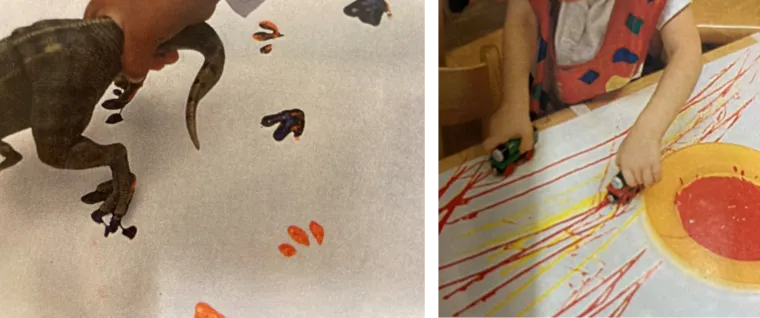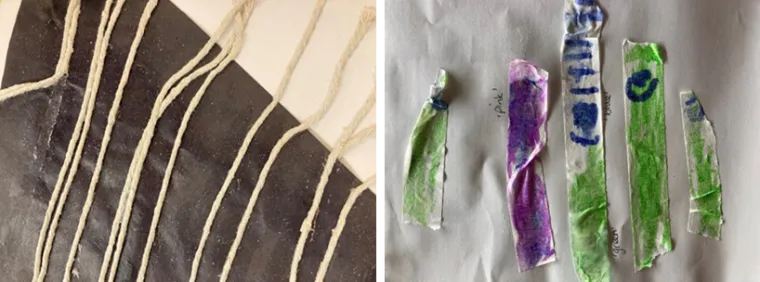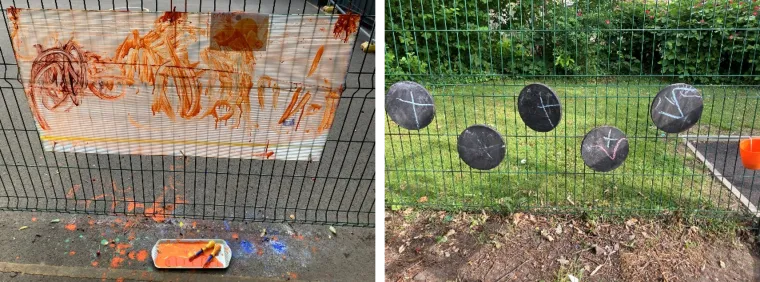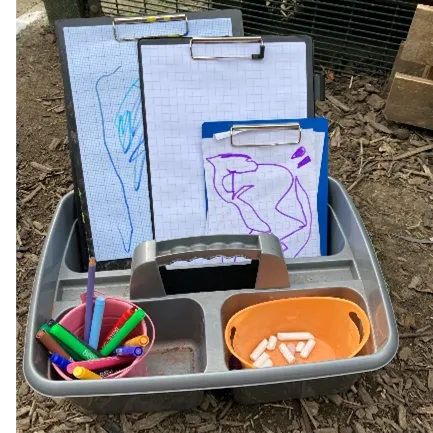News
Blog: Early Mark-Making in Action
30 April 2024By Kate Bate

Kate Bate has over two decades of experience working within education in both teaching and specialist roles. She trained as a primary school teacher and after many years in reception classes, is currently working as an EYFS Nursery Lead Teacher and Early Years Expert Teacher for the Department for Education (DfE). Kate has also worked as a Childminder, and as a Specialist Dyslexia teacher for the DfE and the British Dyslexia Association on the ‘Sound Check Project.’ Kate is passionate about sharing effective practice with others and instilling the desire to create purposeful, engaging and exciting learning environments for every child to enjoy.
What is early mark-making?
Mark-making is the pre-cursor to early writing. Research shows that for writing to develop, young children should be given opportunities to explore ways to make marks which help strengthen their hands, fingers and core strength.
The DfE Fine Motor Skills document explains that ‘from a very young age, children will naturally start to make marks. Babies might use their whole bodies to make marks with mud, paint or cornflour in a tuff tray, or with food at mealtimes. A toddler might splash in a puddle and notice the prints they make. Mark making is an important experience for children because over time they can attribute meaning to their marks.’

Mark Making Matters explains that ‘when children realise that marks can be used symbolically to carry meaning, they begin to use marks as tools to make their thinking visible.’
When thinking about making marks, we can reflect on the Characteristics of Effective Teaching and Learning from Development Matters. It is important that our children are given the opportunity to reflect on their own learning as they explore making marks in an active and developmentally appropriate way. We must, as practitioners, be continually assessing and reflecting on our practice to help each individual child reach their full potential and move them on in their learning.
1. Using hands
Most children love to get messy and use their hands, which is a great way to develop fine and gross motor skills. Making patterns in sand or swirling in shaving foam allows for engaging vocabulary too, like ‘squishy’, ‘slimy’ and ‘soft’. The EEF promotes the importance of teaching through collaborative talk. There are different ways in which we can do this through making marks with the children, from recapping, explaining and showing, alongside questioning and making links. The evidence behind these techniques is summarised online at the EEF Evidence Store.
Add biodegradable glitter, paint, or sequins for that additional bling, or make gloop with cornflour and water and put in a shallow tray, which requires pressure from the child’s fingers to make marks. Finger painting is also really effective in strengthening finger muscles: try painting directly on silver foil for a more glamourous effect or squeezing and rolling playdough or clay.

Psychology of Sport and Exercise research (2021) has shown that introducing the Beery pre-writing shapes to pre-school children, has helped to improve manual dexterity in preparation for reception class. Using these shapes on cards or modelling writing them, can help support mark-making in provision and, according to research, help improve executive function.
2. Using toys
Toys are a great way to encourage even the most reluctant mark-maker. We often print with the feet of dinosaurs or roll the wheels of a train across a large sheet of wallpapering wall paper is great for this. We have even dipped string and cooked spaghetti into paint, then dropped it into a tuff tray to experiment with pattern. Try attaching a felt pen to the back of a chunky car for mark-making fun on wheels. The list is endless!

3. Using tools
Tools are the traditional way to mark-make…. but why not think outside the box? We often use nature and the environment as our inspiration, and paint with vegetables, twigs, leaves; or scrape coloured sand and rice with scrunched up foil on the end of a clothes peg; and roller paint with textured rollers or splat with hand-held mops. Our children love painting trees with water and using washing-up brushes or forks to create painted and printed masterpieces.

4. Ribbon and string
This involves a different form of mark-making and will help children develop their understanding of more abstract concepts, such as counting claps they cannot see and imagining marks left throughout the air. Use language like ‘twirling’, ‘swirling’ and ‘following’ as you dance to music or follow the ribbons as they mark the air. This is a great introduction to pre-writing programmes, such as ‘Write Dance’ and a wonderful way to practise our gross motor skills, whilst crossing the mid-line. Try adding lengths of string and masking tape to your creative table to make patterns and marks in more static ways. You could even attach a tail to a simple kite to explore outdoor movement further.


5. Where to make marks?

We love to make marks everywhere by bringing the wild and wacky into the everyday. Making marks in muddy puddles, wet sand, and on stone flags are a must. Children love to experiment by making marks using twigs and thick brushes – so why not paint onto bed sheets outside, or onto cling film wrapped around tuff tray legs? Cardboard boxes and rolls of paper are a wonderful resource, as are large, cheap sheets of Perspex which can be cable-tied to the fence.
Buying a pot of chalk paint is a great investment – I have lost count of how many surfaces I have painted ready for marks. You can often find off-cuts of wood in builder’s merchants for next to nothing, which can be painted with chalk paint and used anywhere!

Providing little caddies and writing bags in which to pop clip boards and writing materials is a great idea for encouraging mark-making on the move. Introducing map books and trade catalogues can also inspire the children to make marks, and modelling how to write a shopping list or take a telephone message onto notepads is another great way to see mark making in action.
Whatever you do, remember that early mark-making in action is vitally important for each child’s learning and development. Be as creative as you want to and have fun!

Further reading:
Communication and Language: Approaches and practices to support communication and language development in the early years.
Learn more about writing as part of the early years foundation stage (EYFS), including advice from experts and suggested activities.
Help for early years providers – Writing
Learn more about fine motor skills as part of the early years foundation stage (EYFS), including advice from experts and suggested activities.
The National Strategies – Early Years
Non-statutory curriculum guidance for the early years foundation stage.
144 Irlam Road, Flixton
Manchester M41 6NA
Call us: 0161 823 7073
Link takes you to our Twitter page @BF_EYHub



